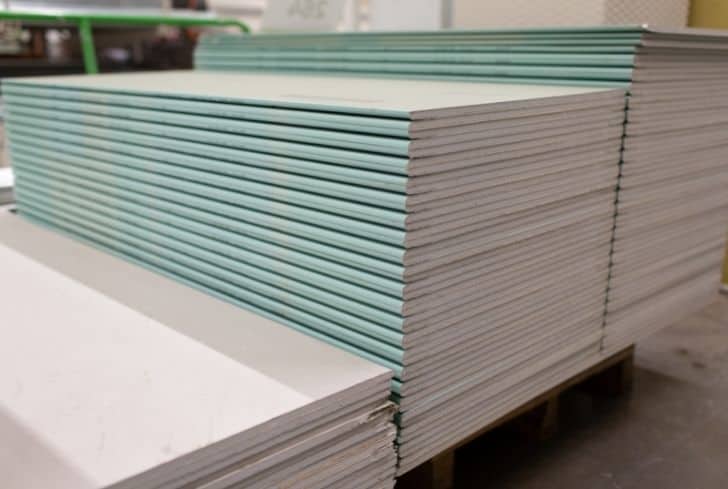If you have wondered how home designers and builders always met all building regulations for acoustic insulation, fire protection, and thermal efficiency, using plasterboard. Plasterboard is a panel produced from gypsum or calcium sulfate dihydrate.
Plasterboard is also referred to as wall panels, gypsum board, wallboard, or drywall. They are usually used to build ceilings and partition wall linings in any type of building, from residential buildings to schools, hospitals, and shops. However, plasterboard produced nowadays can also be used for external sheathing.
During building renovations and constructions, lots of plasterboards are used, and they need to be promptly and safely disposed of. This has raised concerns, and people are asking if plasterboards are hazardous materials and whether they can be recycled.
This blog post will answer these questions and many more regarding the safety of plasterboard, proper disposal methods, and what you can do with plasterboards you want to discard. So, relax and dive in!
Can You Recycle Plasterboard?
Plasterboards are an important material in construction projects, and they cannot be done away with. The main question we will look at is; can plasterboard be recycled?
Yes, plasterboards can be recycled. They are produced from gyprock, which is a sustainable material. However, being a product of gypsum, paper, and small amounts of additives, plasterboards cannot be recycled with other products.
Although plasterboards are recyclable, only a few recycling centers accept them. Here is why; Plasterboards have been banned from being dumped in landfills, and many recycling centers do not accept them. There is a misconception that plasterboard is hazardous. However, this is true only in certain situations.
We mentioned that plasterboard contains gypsum, like sulfate. And if it gets wet or mixed with decomposing waste, a chemical reaction is triggered, resulting in the formation of hydrogen sulfide. If this goes on for a while, the gas can build up and have corrosive or poisonous effects.
This is the major reason plasterboard is banned from landfills. However, the process of forming hydrogen sulfide is very slow and takes a long time to complete. So, it does not cause any environmental damage before the formation of the gas.
Plasterboards can be recycled into new plasterboards without the addition of other materials. The process of recycling old plasterboards is known as closed-loop recycling. The only thing that can make plasterboard unrecyclable is if it has been exposed to contaminants.
Is Plasterboard Hazardous Waste?
Since almost every building has plasterboard installed, there is a question of the safety of plasterboard. Lately, there has been an increased concern for the state of the environment, and everyone must do their best to protect the environment. This leads to the question, is plasterboard hazardous waste?
Of course not; plasterboard is not hazardous waste. It is officially designated as non-hazardous waste. As we mentioned earlier, plasterboard only becomes hazardous waste when it comes into contact with waste that can trigger the chemical reaction to form hydrogen sulfide.
So, when plasterboard is being discarded, it should be contained within a dedicated mono cell (a structure consisting of façade panels, a skeleton, and internal wall panels). The mono cell holds the plasterboard waste, so it does not mix and interact with other waste.
Is Plasterboard Biodegradable?
One of the major qualities an environmentally-friendly material or product must possess is that it must be biodegradable. This means bacteria and microorganisms can break down the product in the soil without causing any adverse effect on the environment during the process.
Since plasterboard is a commonly used product, it is important to know if it possesses this essential quality. Plasterboard is non-biodegradable; bacteria cannot break plasterboard down.
So, plasterboard and other materials containing gypsum cannot be biodegraded; they cannot be taken to the landfill to decompose with other household waste. The gas released when the chemical reaction is triggered is very harmful to the bacteria and microorganisms in the soil.
The gas not only has a horrible smell (like the smell of rotting eggs), but it is also corrosive. And if the entire pile is exposed to fire, there is a risk of an explosion. So, before disposing of plasterboard with any recycling center, it is important to call ahead and make inquiries.
Is Plasterboard the Same as Drywall?
It would be difficult to know if drywall and plasterboard are the same or different if you are not a construction professional. But for your understanding, we will look at both of them to see if they are similar or different.
Plasterboard is slightly different from drywall, but both products can be used interchangeably. We will examine the differences between these two products.
Drywall is a construction panel for the interior of buildings used for making ceilings and walls. It is produced from a hardened gypsum core with long edges and thick paper on the back and front.
On the other hand, plasterboard is designed to be the base for plaster. It is an absorbent face paper; usually blue, used to finish coats and accept plaster base. Plasterboard is much thicker and harder than drywall, and it is usually found in older homes.
Drywall can be good for fire resistance, sound control, and prevention of mold and mildew. While plasterboard acts as a good sound barrier, does not break easily, and reduces buckling. Nevertheless, drywall has become the more popular choice for the interior because it is easier to install, repair and is less expensive.
Both products, drywall, and plasterboard are produced pretty much the same way. The gypsum is combined with additives like paper pulp to create a paste or slurry. The paste is spread between thin layers of fiberglass or paper backing. After which, it is heated to harden and dry.
After it has dried, the boards are cut up into different sizes for different purposes. They have a common width of four feet, but the height varies. The thickness of the boards also varies according to the purpose of the boards.
The process of installing drywall and plasterboard is also similar. Both products can be mounted on anything, from metal to cement blocks and wood studs. The boards are first mounted on the wall using fasteners. Then the seams between the boards are taped.
To ensure a smooth look and get rid of any sight of seams, a compound is applied over the tape. And several coats of the compounds if applied to achieve a flawless appearance. The board is then sanded smooth, and it can also be textured with different techniques; it all depends on the desired finish.
So, while drywall and plasterboards may be slightly different, they have a lot of things in common, from the method of production to uses, installation, and even benefits.
Is Gyprock Plasterboard?
Another misconception is if gyprock is plasterboard or they are completely different products. Gyprock is plasterboard, and it is also called gypsum board or drywall. Gyprock or gypsum board is the generic name for all building material produced from the combination of paper facers and gypsum.
The only difference is the usage; different countries use different names. Some might use plasterboard and other countries, gyprock, and still, others refer to the product as drywall. There is no difference between gyprock and plasterboard.
7 Amazing Ways to Dispose of Plasterboard
Recycling is one of the best ways to dispose of old items, and it is an eco-friendly method that protects the environment. However, there are other ways to dispose of old and unwanted items. This involves reusing the items for other purposes; this is referred to as upcycling. Let us see how you can upcycle plasterboard.
1. Give It Out
One of the best things to do is to affect humanity positively. There are people who are definitely in need of plasterboards and are unable to afford them. You can reach out to local contractors and see if they require some extra pieces.
You can also check online, like Facebook or Craigslist, and give it away for free. There are tons of people who would appreciate the gesture.
2. Fancy Ceiling Designs
Plasterboards are easy to work on, and they are easy to install when you have the proper materials. So, if you have a couple of old plasterboards lying around, you can get creative and use them to create beautiful ceiling designs for your home.
You can carve out the shape of a butterfly for the children’s room, and in the living room, you can fashion out a creative and beautiful design. You can also play around with colors.
3. Plasterboard Shelves and Shelving
Another creative way to upcycle old plasterboard is to create shelves and shelving. You can use them to create a kind of storage shelf, to store books and other essential items.
First, you need to create the design on paper and ensure you get the right measurements before you start. With some tutorials online, you can create shelving of different shapes, designs, and sizes for different usage across your home.
4. Plasterboard Arches
A common feature among high-end homes is the beautiful arches leading to different parts of the house. You can also create that in your home; you can create doorways in the form of arches to separate neighboring rooms.
This idea is perfect for people with smaller apartments. You do not need to be a professional to make a good arch. If you want, you can carve out the arch in different shapes, and you can design the arch to meet your taste.
5. Plasterboard Partitions
If you need to divide a part of your home into several zones, you would need partitions. Is there any better way of creating partitions than with plasterboards?
The beauty of plasterboard partitions is that you can use them to divide a room as well as display and showcase luxury items and valuable collections.
6. Plasterboard Cabinets
Plasterboards are one of the most versatile building materials. Construction workers use them for major projects, and homeowners can also use them for minor projects.
You can create cabinets from plasterboards in your home. The only downside to plasterboard cabinets is that they cannot be moved around. You can create cabinets of different sizes for different rooms and for storing different items.
7. Plasterboard Bar Counter
If you have always wanted to own a personal bar at home, here is the opportunity to do that. You can carve out a bar counter from plasterboard and decorate it the way you want.
Remember, you must create small shelves within the counter for storing drinks. The good thing about the plasterboard bar counter is that it can be placed anywhere in the home.
Conclusion
Plasterboard or drywall or gypsum board, or gyprock is very versatile material. Although only a few people are aware of its environmental effects. Now that you have knowledge of the environmental effects and how to recycle and upcycle plasterboard properly, you should have no trouble.






